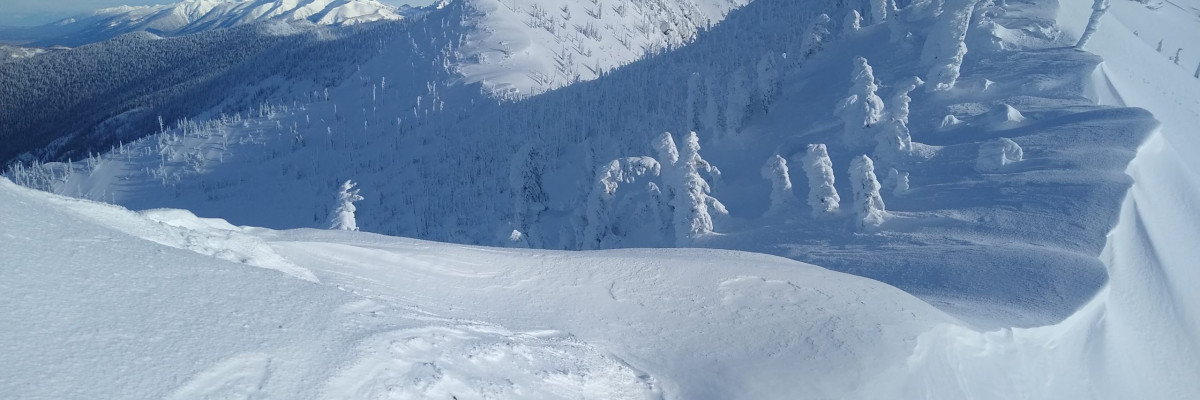The avalanche danger in the west central Montana backcountry is Considerable.
Good morning, this is Jeff Carty with the West Central Montana Avalanche Center’s avalanche advisory for December 19, 2020. This advisory does not apply to operating ski areas, expires at midnight tonight, and is the sole responsibility of the U.S. Forest Service.
Mountain temperatures are 24º to 29º this morning. They are forecast to be 24º to 36º today.
The mountains received between .4″ and .8″ of snow water equivalent in the past 48 hours. 3-4” of snow are forecast today with up to an additional 14″ by tomorrow night. Winds have been 12 mph to 20 mph, with gusts to 30. Today winds will reach 33 mph, with gusts to 61 mph, and will continue through Sunday night.
Rapid loading by wind and snow, as we are forecast to receive in the next 48hr, could trigger a widespread avalanche cycle.
The conditions yesterday were similar to two days prior with the addition of 4”-8″ of new snow. This has buried weak layers deeper. Whumfing and cracking are happening more frequently, indicating the snowpack is stressed by the increased load. Buried surface hoar and near surface facets are propagating in stability tests indicating that slab avalanches are possible. Mid elevations, 5000′-7500′, and shallow areas such as wind swept ridges and south faces have the poorest snowpack structure and are the most likely places to trigger an avalanche on these problem layers.
Whumfing was reported yesterday at Lolo Pass, Lost Trail, and The Swans. Facets and buried surface hoar are the culprits in these areas. The Rattlesnake had a variety of stability concerns on all aspects, involving the same problem layers. The central Bitterroot, at St. Mary’s, primarily had a storm slab problem that will be more likely to propagate with further loading and consolidation.
Wind slab remains a concern on upper elevation leeward slopes. These will grow rapidly today with strong winds and additional snow. Windslab may be deposited lower on slopes due to strong wind transport. In many areas, windslab will be deposited on near surface facets that could increase touchiness and remain unstable for longer than windslab alone.
Many areas are also plagued by faceting deep in the snowpack. These layers are not yet propagating consistently in stability tests but the structure is very poor. The snowpack on Pyramid peak is composed entirely of noncohesive facets, reminiscent of our snowpack leading up to the January avalanche cycle last year. Other peaks in the area likely have a similar structure. There is some concern that as snow accumulates, it may overload these faceted layers and cause larger avalanches.
The Bottom Line:
New snow has continued to load a variety of persistent weak layers. Red flags such as whumfing and shooting cracks have increased, indicating that stability has decreased. The likelihood of avalanches will increase with continued snowfall. Wind slab will build quickly today and become touchy. Avoiding slopes over 30º and enjoying low angle powder is a good plan during the next couple of days. As always, practice safe travel protocols. Travel one at a time in avalanche terrain, carry a beacon, shovel, and probe, and stay alert for signs of instability. Dig a pit. Look for red flags.
The current storm cycle coincides with the start of the holidays and we expect to see more people out in the backcountry in the coming week. Please exercise caution. We are coming out of a long stretch of low hazard and no snow. The draw of fresh powder is strong but we may be entering into a very active avalanche cycle.
We generate avalanche forecasts for a 1420 square mile area that stretches from Lost Trail Pass to just north of Seeley Lake. We work hard to keep you informed of current avalanche dangers but, we can’t see everything. Your snowpack and weather observations help us fill in the gaps and produce a more accurate forecast. If you get out, please take a moment to fill out the online observation form.
Ski and ride safe.
























